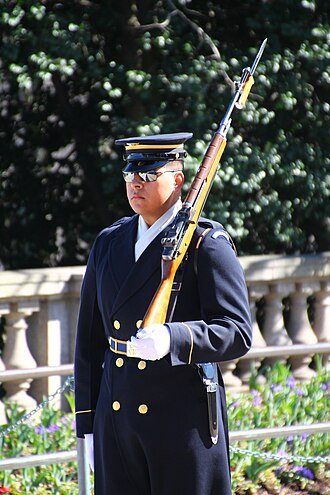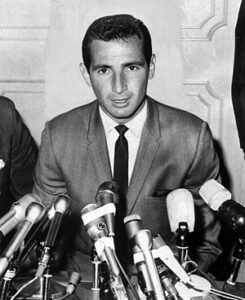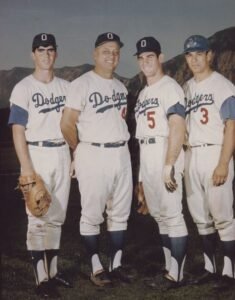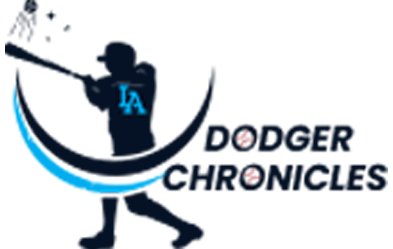
November,18, 1966. In a press conference, Sandy Koufax announced he was retiring from baseball. Virtually over-night, the Dodgers went from a pennant winning team, to a second division team in the National League. It would be 1969 when the leagues would split into four different divisions. The Dodgers for their part, were not taken by surprise. They had in fact asked Sandy to delay his announcement so they could try to trade for a replacement. Koufax declined to do so. Thus, angering some in management.

But Sandy was not the only member of the 66 champs who would be leaving town. After the series, the Dodgers went to Japan on a good will tour. SS Maury Wills had asked permission to miss the trip because he was banged up from the season. Walter O’Malley said no, and Maury went with the team. After a few games he left and said he was going back to Los Angeles for treatment. On the way home, Maury stopped in Hawaii. He was spotted there on stage with Don Ho, playing his banjo.
O’Malley was incensed. He said Wills had brought dishonor and shame to the Dodgers and Japan. He then ordered GM Buzzie Bavasi to get rid of Wills. On December 1st, Wills was traded to the Pittsburgh Pirates for 3B Bob Bailey and SS Gene Michael. The day before he traded Tommy Davis and Derrell Griffith to the Mets for Jim Hickman and Ron Hunt.
The rebuild had begun. As the calendar turned to 1967 it was very obvious that the Dodgers were going to have a different look. They traded SS-3b John Kennedy to the Yankees on April 3rd for Jack Cullen, John Miller and 25,000 dollars. They made some minor moves, but on May 10th, they traded John Werhas to the Angels for Len Gabrielson, who would become the fourth outfielder on the team for the next four years. In the June draft, they selected five players. Only one would come to the majors with them, Steve Yeager. One other, Bruce Ellingsen, would later be used in a trade that would bring them Pedro Guererro. They also signed an undrafted free agent who would spend some time in the majors, Von Joshua.
In 1967 they finished 73-89 in 8th place in the 10 team NL. That winter they traded the very popular, Lou Johnson to the Cubs for Paul Popovich and Jim Williams. They also made a big trade with the Twins sending Perranoski, Roseboro and Bob Miller for Zoilo Versailles and Mudcat Grant. In 1967 there was a secondary draft in January, and the Dodgers selected two players who would eventually play for them, Davey Lopes and Geoff Zahn.
In February they traded Ron Hunt and Nate Oliver to the Giants for Tom Haller. They then purchased Rocky Colavito from the White Sox. They also sold Gene Michael to the Yankees. Which turned out to be fortuitous move for him. He later became the Yanks GM. In April they traded Jim Hickman and Phil Regan to the Cubs for Jim Ellis and Ted Savage.

Buckner, Lasorda, Garvey, Valentine
The June 1968 draft would be a gold mine for the Dodgers. It has long been considered their best draft class ever. It netted 8 players who would see time in the major leagues. Ron Cey, Steve Garvey, Bobby Valentine, Bill Buckner, Sandy Vance, Tom Paciorek, Joe Ferguson, and Doyle Alexander. Quite the haul. Unfortunately for the Dodgers, those guys were still a few years away. They finished in 7th place with a 76-86 record. 1968 did have one bright spot for the Dodgers, Don Drysdale, in his last full season in the majors, pitched six consecutive shut-outs and 582/3rds scoreless innings. A mark that would stand until Orel Hershiser passed it 10 years later.
That winter, baseball was expanding and adding two teams to the NL. So, the Dodgers lost these players in the draft. The Padres took, Versailles, Ferrara, and Jim Williams. The Expos took Grant, Billingham and Jim Fairey. LA sold Bailey to the Expos in October, and traded Jim Ellis to the Cardinals for Pete Mikkelson. They then traded Koufax’s replacement in the rotation, Mike Kekich, to the Yankees for Andy Kosco. In the January draft they got Lee Lacy.
Now in the Western Division of the National League, the Dodgers got back over.500, 85-77 for the first time in two years and finished 4th. Drysdale was forced to retire with a torn rotator cuff. Bill Singer, Claude Osteen and Don Sutton were the leaders of the staff. Singer would throw a no-hitter in 1970. But in 1969, he was the first pitcher to record a credited save. He did so in relief of Drysdale. Vin Scully had named him, ” The Singer Throwing Machine.” The Dodgers also brought back Maury Wills along with Manny Mota in a trade for Ron Fairly and Pail Popovich with the Expos. The 69 team was not a very good hitting team, Kosco led the club with 19 homers and the team batted .254.
In the winter of 69, they continued rebuilding the team. There was still a draft in January, but neither of the two players they drafted signed. In June they drafted only three players who signed. Doug Rau, Lance Rautzhan and Greg Shanahan. Their other draftee did not sign but was drafted by the Cardinals the next year and went on to play 10 seasons in the majors. Mike Vail, an outfielder. Rau had the longest career. 9 years with LA and one in Anaheim.
They played better in 1970, finishing second in the NL West with an 87-74 mark. One game was rained out and not replayed. That winter they sent former ROY, Ted Sizemore and a catcher, Bob Stinson, to the Cardinals for Dick Allen. Allen would not put up the same kind of numbers he did in Philly or St. Louis, but he had a decent year. He also clashed with Walter Alston. He would be sent to the White Sox for Tommy John after the season. They also traded Alan Foster and Ray Lamb to the Indians for Duke Sims, a catcher.
In February of 71, they traded Andy Kosco to the Brewers for Al Downing. Downing would be a 20-game winner for the only time in his career that season. He is also known as the guy who gave up Hank Aaron’s 715th homer. In June, they drafted seven players, but only signed four of them. P Rick Rhoden, P Rex Hudson, OF John Hale and C Kevin Pasley. Rhoden would have a decent career with LA and the Pirates. Hudson pitched in one MLB game in 1974 and was lit up for 5 runs in 2 innings and never pitched in the majors again. Hale played part of six seasons. Pasley played 55 games in the majors with the Dodgers and Mariners. He was the last Dodger to wear #4 before it was retired for Duke Snider.
The 71-team finished in second place again, this time recording 89 wins and 73 losses. They were only one game behind the Division leading Giants. They had been as many as 9 games down in August. Their first trade that winter sent Tom Hutton to the Phillies for Larry Hisle. On the second of December, they traded Tom Haller to Detroit. Then they traded Allen to the White Sox for John and Steve Huntz. Then the same day came the blockbuster, Doyle Alexander, Bob O’Brien, Sergio Robles and Royle Stillman to the Orioles for Frank Robinson and Pete Richert.
P Dennis Lewallyn was drafted in January. They drafted six players in June, but only OFs Bobby Detherage and Glenn Burke signed. One of the players they drafted, P Bob Shirley, would wait until the 1974 draft to sign and went to the Padres. The 72 team would finish second for the third straight year, but they only played 155 games that season, and finished with an 85-70 mark. For the first time, the players went on strike prior to the season starting and it lasted from April 1st to the 15th.
After the season, they said goodbye to two old friends, Maury Wills, who had been replaced at SS by Bill Russell, the first of the class of 68 to secure a starting job. Garvey was playing 3rd, but that would not last long. The other player they said goodbye to was Ron Perranoski. Hisle was traded to the Phillies in October, and Jim Lefebvre was released in November. Alston had felt Robinson was always second guessing him and in November, in another block buster deal, they sent Robinson, Grabarkewitz, Bill Singer, Mike Strahler, and Bobby Valentine to the Angels for Ken McMullen, who was traded to DC in the Claude Osteen deal in the winter of 64, and Andy Messersmith.
In 1973, the class of 68 finally started to make their mark on the organization. Four of them were everyday starters and played 136 games or more. Joe Ferguson, 136, Bill Buckner, 140 split between 1st and the OF, Bill Russell, 162, and Ron Cey, 152. Steve Garvey playing 1st more than 3rd was in 114 games and hit .302. Ferguson led the team in homers 25, and RBIs, 88. The transition to the team that would go to three World Series was well underway.
They drafted four players in June, but only Joe Simpson and Mike Dimmel signed. They drafted P Bob Stanley, but he waited a year until he was drafted by the Red Sox in 74 and became a decent relief pitcher. Simpson would play 9 years in the majors with the Dodgers, Mariners and Royals, but would go on to a broadcasting career. Dimmel never made it to the bigs with the Dodgers. But he had a cup of coffee with the Orioles.
Over that winter, a couple of long-term Dodgers left. Wes Parker retired, and Willie Davis was traded to the Expos for P Mike Marshall. The 73-team finished second again but were only 3 1/2 games behind the Reds. A seven-game improvement. They traded Claude Osteen and a minor leaguer to the Astros for Jimmy Wynn, and the transition would be complete in 1974. Except for Jimmy Wynn, and Willie Crawford, signed as an amateur free agent in the early 60’s, the starting lineup featured 6 position players drafted by the Dodgers. C Yeager, 1B Garvey, eventual NL MVP, 2B, Lopes, SS Russell, 3B Cey, LF, Buckner. Among the reserves they had Ferguson, Paciorek, Lacy, all draftees.
The 74 team would win 102 games, beating the Reds by 4. Take the NLCS against the Pirates, 3-1 and then lose the World Series to the A’s, 4 games to 1. Oddity of that series was that four of the games were decided by scores of 3-2. The other game was a 5-2 win for the A’s. The losing team scored only 2 runs in all five games. It was also the last pennant winner and World Series for manager, Walter Alston. Alston would retire in 1976 with two games left in the season, and 3rd base coach, Tommy Lasorda, who had managed almost all of the class of 68 in the minors, became only the second manager in LA Dodger history. Tommy would manage the team for 20 years until he had a heart attack and was forced to retire. He is second only to Alston in years as the manager. Wilbert Robinson is the third with 18 years.
With Lasorda at the helm, the transition was complete. They would go to two more World Series, 77-78 before finally winning it all in 1981. A few of the class of 68 would not be with the Dodgers for those runs. Buckner was traded to the Cubs for Rick Monday after the 1976 season. Tom Paciorek was part of the trade for Dusty Baker along with Lee Lacy and Jerry Royster and Jimmy Wynn. Many members of that class would have long careers in baseball.
Bobby Valentine would play ten years in the majors. He never quite reached the heights expected of him. A bad injury took away a lot of his speed. He then managed in the majors with three teams, Texas, the Mets and Red Sox for 16 years. Buckner played in the majors for 22 years with the Dodgers, Cubs, Red Sox, Angels, and Royals. He won a batting title with the Cubs in 1980. Unfortunately, he is mostly remembered for his error in the 86 World Series that cost Boston a crucial game.
Garvey, Lopes, Russell and Cey were together as a unit longer than any other infield in MLB history, 8 years. One by one they were traded or left by free agency except Russell. He finished his career with LA as a player, staying active for 18 years, tying Zack Wheat in that record. He then coached and became manager after Tommy Lasorda had to retire. Yeager played 14 of his 15 big league seasons with the Dodgers. He was also the Dodgers catching instructor from 2012-2018. Joe Ferguson played for the Dodgers for 11 of his 14 years in the majors. He was traded to the Cardinals in 1976 as part of the Reggie Smith deal. He returned to the Dodgers in a trade with the Astros in 1978 which sent Rafael Landestoy and Jeffery Leonard to the Astros. After his playing career, he coached for the Rangers under Bobby Valentine and did some minor league managing. He was the Dodgers bench coach in 1991. Joe is also remembered for his memorable throw from the outfield in the 74 series that nailed an A’s runner at the plate trying to score.
It has to be said that the drafts following the seasons from 67-73, shaped the Dodger franchise and fortunes well into the late 80’s. They changed the face of the franchise and indeed marked the changing of the guard.
Born June 14th, 1948, in Los Angeles California. AKA The Bear













A nice trip down memory lane. Thanks, Bear!
Go Dodgers!!!!!!!!!!!!!!!!
Another fantastic effort Bear! There was a lot of turnover of players during that period. Many established stars came and went during those years To have the beginning of a starting infield that was intact for so many years was one of the highlights in Dodger history.
Having Billy Buckner go down with that serious ankle injury was a devastating for me in that he was my favorite player at the time. It was similar to the Tommy Davis injury in that it robbed the player and fans the opportunity to watch them maximize their baseball talents.
Awesome post Bear. Thanks. I was a young Dodger fan during that time. A lot of names that I had forgotten about. It seems to be a forgotten or overlooked period in the Dodger timeline. But it did set them up for a lot of future success.
Great read Bear. I remember those down years all too well.
I agree. Good read Bear.
I’ve been reading a bit on college baseball NIL and I found there isn’t as much money there as I thought there would be. Even scholarships are often not full ride. Sometimes universities offer first year everything paid but by the senior year no money is left. Only a few universities out there are offering enough to get MLB drafted players from signing contracts. Not surprisingly baseball is way behind football and basketball in this regard. Baseball just bring in as much money. However there are places where money is available. The SEC of course is one of those places.
I was thinking about what a 2024 changing of the guard would look like. Also, I was thinking that you did a great job today Bear. You earned your keep. Checks in the mail.
There could be a team willing to roll the dice in hopes of getting a future stud rotation. By rolling the dice, I mean giving up a pearl for a possible bigger return.
Frasso, May, Gonsolin. They could anchor a rotation next year.
Kike’, Taylor, Muncy, Heyward. They could be the veterans that could keep a young team grounded.
Thanks guys, I appreciate all of the kind words. It was fun to go on baseball reference and backtrack all of those drafts. I found it interesting that two guys they did not sign had decent careers elsewhere. Bob Stanley and Bob Shirley. Stanley pitched 13 years in the majors, all with Boston. He started out as a starting pitcher, by 1983, he was Boston’s go to guy. He was on the mound when Buckner missed Mookie Wilson’s ground ball. Had a 115-97 career record with 132 saves. Shirley pitched for 11 years with the Padres, Cardinals, Reds, Yankees and Royals. He was drafted three times before he finally signed with the Padres. LHP, was 67-94 in his career.